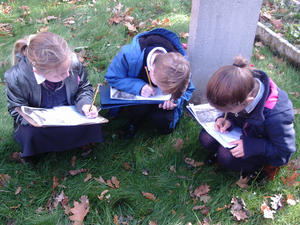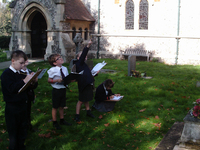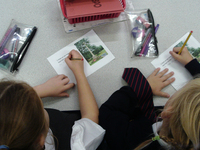- County name: Norfolk
- Group/School name: Hopton Church of England Primary Academy
- Age group: 5 - 11
- Group type: Year 3
In collaboration with Historic England’s Heritage Schools Programme, War Memorials Trust’s Learning Officer has agreed to carry out a school visit or training session in each of the Heritage Schools Regions during the last year of the First World War centenary. When discussing a possible visit the Local Heritage Education Manager (LHEM) for the East suggested a primary school in Hopton-on-Sea near Great Yarmouth. The LHEM had worked with the school in the past on the heritage of the village but had not looked at the war memorial in detail. The year 3 teacher had done some research in her own time on the people commemorated on Hopton war memorial and was delighted to be offered the opportunity to receive a visit by War Memorials Trust. Our Learning Officer spent the whole day with the year 3 pupils at Hopton Church of England Primary Academy.
The morning began with a session on what war memorials are as the pupils had very limited knowledge about war memorials or either of the World Wars. Pupils were shown images of a variety of war memorials and asked to consider what they are, what they look like and what they are made from. Key words the children suggested included: soldiers, statues, remembers World Wars, names, stained glass windows, people who have died in the wars, stone, wood, metal. The collection of words could all be referred to when WMT’s Learning Officer shared a definition of what a war memorial is. Some images of war memorials from the local were then shared with the pupils including a war memorial in Great Yarmouth which was unveiled in 1817 and commemorates the Napoleonic War (www.warmemorialsonline.org.uk/memorial/104112). This was used to highlight that some war memorials commemorate wars other than the First and Second World Wars.
Pupils were then asked to consider how many war memorials there are in the UK. The most popular answer from the range was 10,000 so they were quite surprised to learn that there are actually around 100,000. Using a timeline, it was then highlighted that around two-thirds of this number were created in the wake of World War I. War memorial inscriptions were then used to support discussions around why there was a wave of memorialisation at this particular time.
The final part of the first session looked at some of the problems which face war memorials. These included age and weathering, vandalism, theft and building closures. During the earlier part of the session pupils had been shown a war memorial which took the form of a hospital wing at Lowestoft and North Suffolk Hospital. Unfortunately the hospital is no longer used by the NHS and redevelopment of the site is possible. This put the issues facing war memorials in a local context.
After breaktime, the class walked through Hopton to St Margaret’s Church. On this walk the LHEM stopped the children and with the use of photographs highlighted how the village had changed. One of the most surprising changes was that the railway bridge which used to cross one of the roads no longer exists. The historic photograph and the road today look incredibly different. Upon arriving at the church, the pupils were asked to look at the war memorial (www.warmemorialsonline.org.uk/memorial/254753) and describe what they could see. The cross with Jesus on one side and the Mother and Child on the reverse were pointed out, as were the names, the inscription, the date of World War II and the laurel wreath surrounding the First World War inscription.
Pupils then carried out a condition survey in small groups focusing either on the lettering (Building Surveyors), the structure and material of the memorial (Conservators) or the area around the war memorial (Landscape Suveryors). The pupils did a fantastic job of highlighting the problems they saw and were very fair in the judgments they made about the condition of their specific focus. While at the church, pupils also had the opportunity to go inside and look at a smaller memorial dedicated to an individual (www.warmemorialsonline.org.uk/memorial/254835) and were shown a CWGC grave within the churchyard.
Upon returning to the classroom pupil were asked to reflect on their morning and consider why Hopton war memorial is important. One of the reasons shared was:
“people have fought in the war and they deserve to be remembered and they tried to keep us safe.”
The afternoon began by uploading the condition survey to War Memorials Online (www.warmemorialsonline.org.uk/report/254753/view/condition/206059). The overall condition given by the pupils was Fair. It was thought that the memorial was generally well looked after although there was a quite a lot of biological growth on the stone. However this, for the time being, did not detract from the readability of the inscription and names.
The rest of the afternoon provided an opportunity for pupils to look more closely at war memorial designs and what some of the features mean. Pupils were shown a selection of images and asked to spot different symbols and design features: these included flag, wreathes, Victory, Peace, St. George, and a broken pillar. Pupils then used this knowledge to design their own war memorials. Pupils took great care in the designing these and many included symbols like doves, laurel wreathes, poppies and crosses. The class teacher hopes that these designs can be turned into models which can be used as part of the school’s Remembrance service.
The day was hugely successful and the pupils should be very proud of what they learnt and what they achieved. The level of understanding and attitude towards commemoration was equal to pupils that were much older. The work they have done so far will be used as part of a Listing application for Hopton war memorial.





